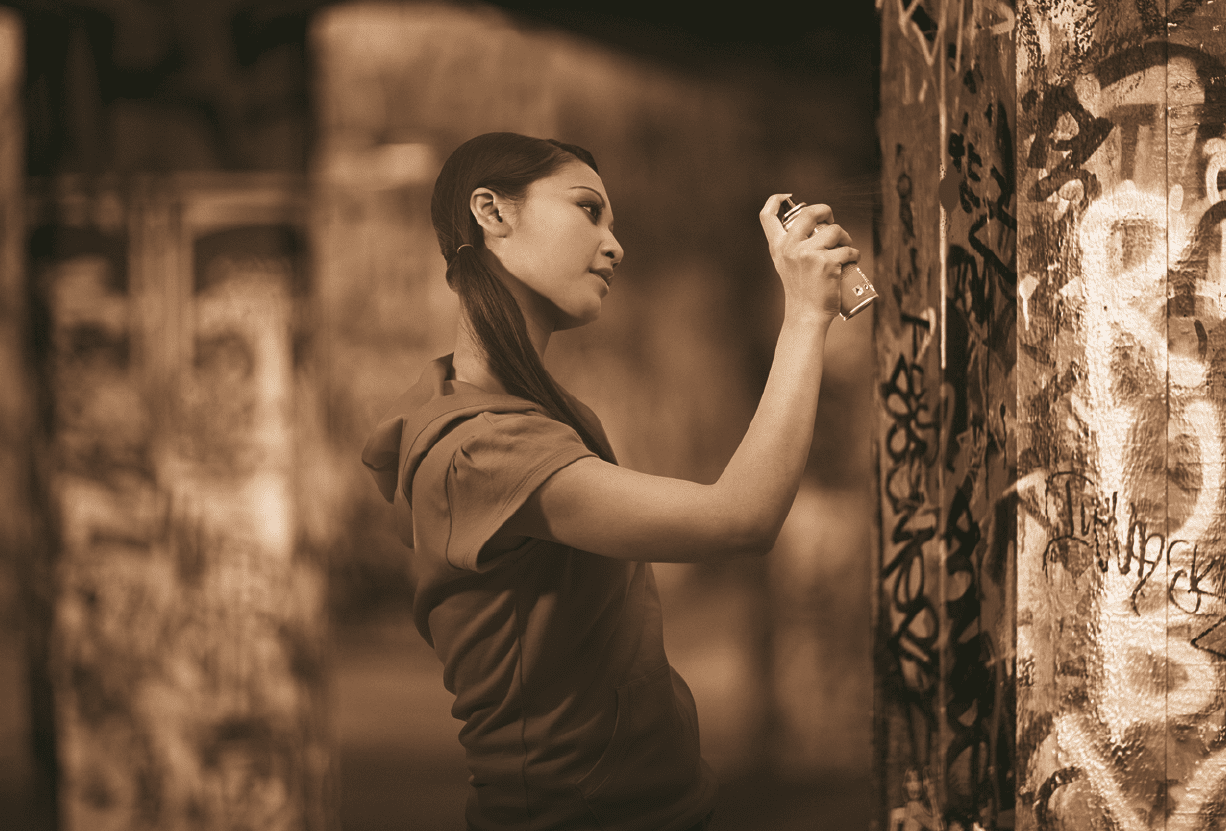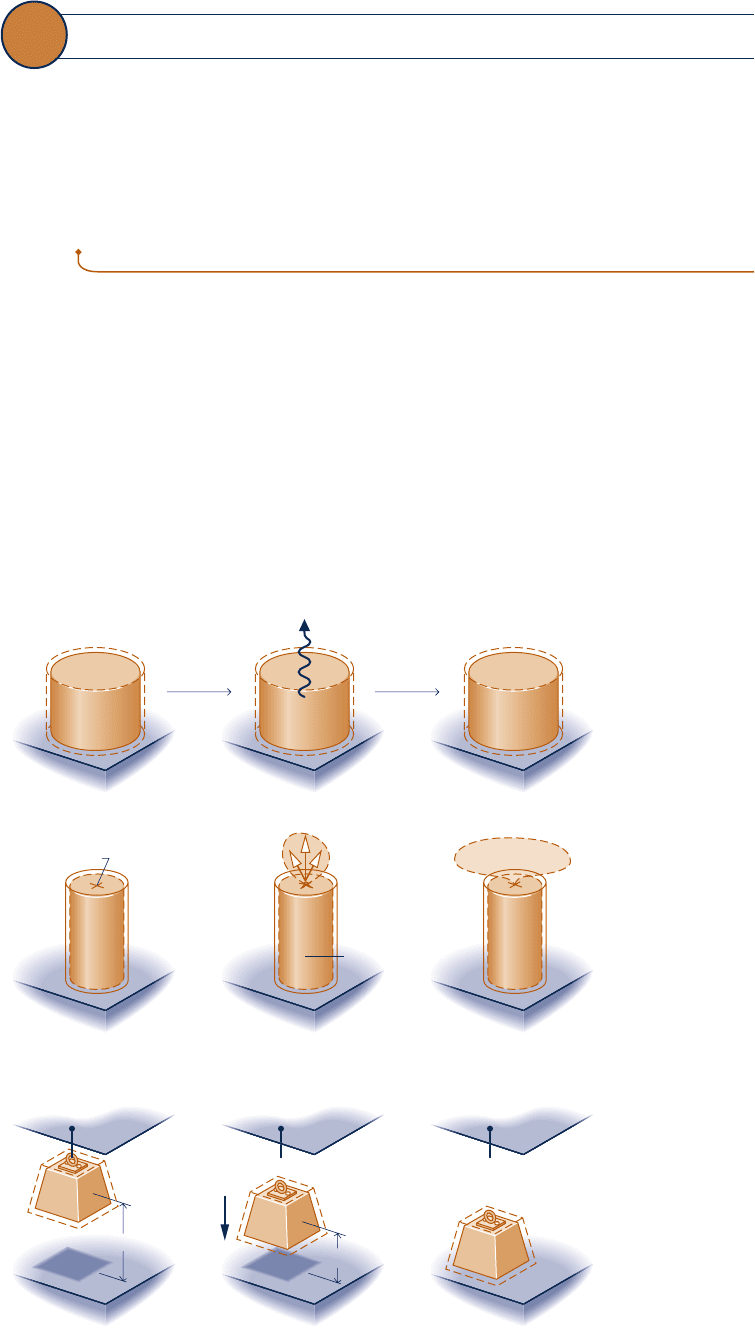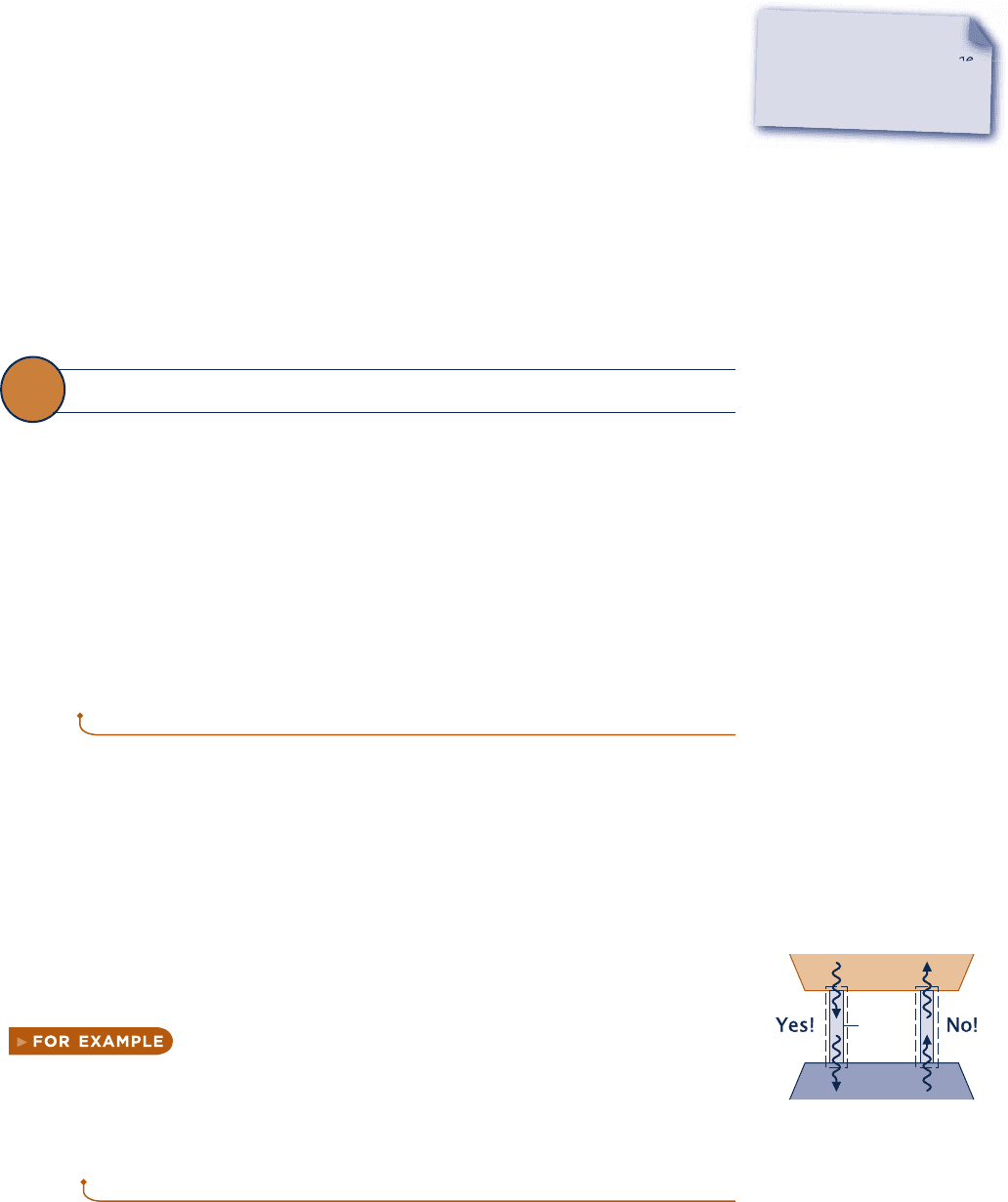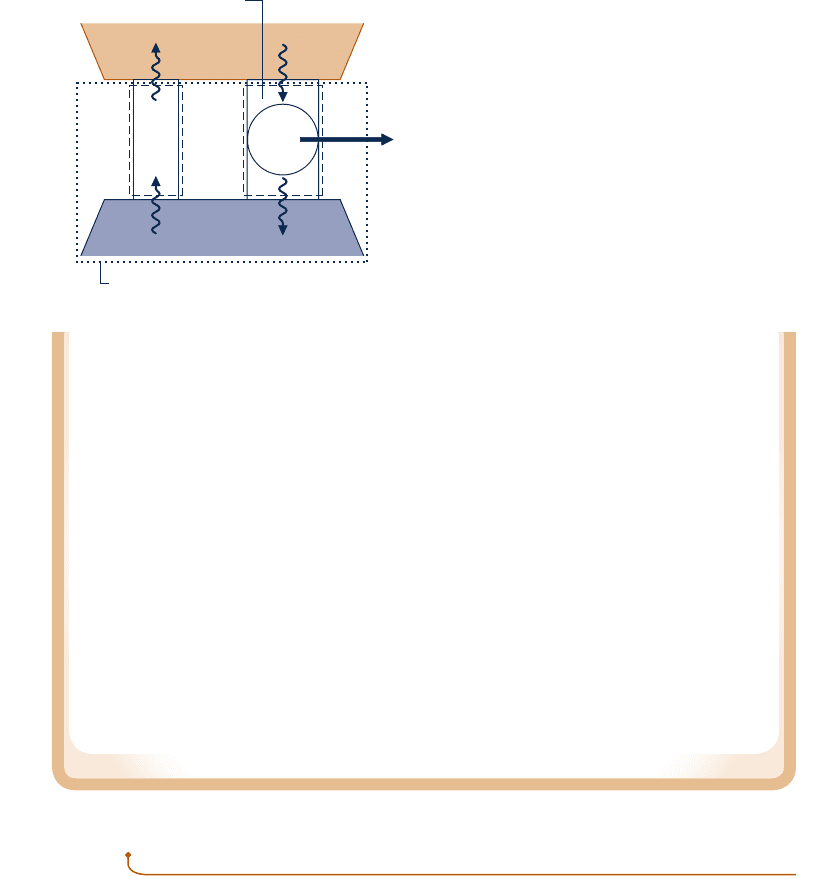Moran M.J., Shapiro H.N. Fundamentals of Engineering Thermodynamics
Подождите немного. Документ загружается.

c04ControlVolumeAnalysisUsingE233 Page 233 6/23/10 9:42:26 AM user-s146 c04ControlVolumeAnalysisUsingE233 Page 233 6/23/10 9:42:26 AM user-s146 /Users/user-s146/Desktop/Merry_X-Mas/New/Users/user-s146/Desktop/Merry_X-Mas/New

234
Unrestrained expansion of a gas or liquid, including spray paint, is one of the irreversibilities
listed on p. 243.
Image Source//Getty Images, Inc.
ENGINEERING CONTEXT The presentation to this point has considered thermodynamic analysis
using the conservation of mass and conservation of energy principles together with property relations. In
Chaps. 2 through 4 these fundamentals are applied to increasingly complex situations. The conservation
principles do not always suffice, however, and the second law of thermodynamics is also often required for
thermodynamic analysis. The objective of this chapter is to introduce the second law of thermodynamics. A
number of deductions that may be called corollaries of the second law are also considered, including per-
formance limits for thermodynamic cycles. The current presentation provides the basis for subsequent devel-
opments involving the second law in Chaps. 6 and 7.
c05TheSecondLawofThermodynamics.234 Page 234 6/29/10 1:21:49 PM user-s146c05TheSecondLawofThermodynamics.234 Page 234 6/29/10 1:21:49 PM user-s146 /Users/user-s146/Desktop/Merry_X-Mas/New/Users/user-s146/Desktop/Merry_X-Mas/New

The Second
Law of
Thermodynamics
5
When you complete your study of this chapter, you will be able to...
c
demonstrate understanding of key concepts related to the second law of thermodynamics,
including alternative statements of the second law, the internally reversible process, and
the Kelvin temperature scale.
c
list several important irreversibilities.
c
assess the performance of power cycles and refrigeration and heat pump cycles using, as
appropriate, the corollaries of Secs. 5.6.2 and 5.7.2, together with Eqs. 5.9–5.11.
c
describe the Carnot cycle.
c
interpret the Clausius inequality as expressed by Eq. 5.13.
LEARNING OUTCOMES
235
c05TheSecondLawofThermodynamics.235 Page 235 5/28/10 2:23:24 PM user-s146c05TheSecondLawofThermodynamics.235 Page 235 5/28/10 2:23:24 PM user-s146 /Users/user-s146/Desktop/Merry_X-Mas/New/Users/user-s146/Desktop/Merry_X-Mas/New

236 Chapter 5
The Second Law of Thermodynamics
5.1 Introducing the Second Law
The objectives of the present section are to
motivate the need for and the usefulness of the second law.
introduce statements of the second law that serve as the point of departure for its
application.
1.
2.
5.1.1
Motivating the Second Law
It is a matter of everyday experience that there is a definite direction for spontaneous
processes. This can be brought out by considering the three systems pictured in Fig. 5.1.
c System a. An object at an elevated temperature T
i
placed in contact with atmo-
spheric air at temperature T
0
eventually cools to the temperature of its much larger
surroundings, as illustrated in Fig. 5.1a. In conformity with the conservation of
energy principle, the decrease in internal energy of the body appears as an increase
in the internal energy of the surroundings. The inverse process would not take place
spontaneously, even though energy could be conserved: The internal energy of the
surroundings would not decrease spontaneously while the body warmed from T
0
to its initial temperature.
Air at
p
i
> p
0
Atmospheric air
at T
0
Atmospheric air
at p
0
Va lv e
Body at
T
i
> T
0
Q
T
0
< T < T
i
T
0
Air
Air
at
p
0
Time Time
Mass
Mass
z
i
Mass
p
0
< p < p
i
0
< z < z
i
(a)
(b)
(c)
Fig. 5.1 Illustrations of
spontaneous processes and
the eventual attainment of
equilibrium with the
surroundings. (a) Spontaneous
heat transfer. (b) Spontaneous
expansion. (c) Falling mass.
c05TheSecondLawofThermodynamics.236 Page 236 5/21/10 12:26:39 PM user-s146c05TheSecondLawofThermodynamics.236 Page 236 5/21/10 12:26:39 PM user-s146 /Users/user-s146/Desktop/Merry_X-Mas/New/Users/user-s146/Desktop/Merry_X-Mas/New

5.1 Introducing the Second Law 237
c System b. Air held at a high pressure p
i
in a closed tank flows spontaneously to
the lower pressure surroundings at p
0
when the interconnecting valve is opened,
as illustrated in Fig. 5.1b. Eventually fluid motions cease and all of the air is at the
same pressure as the surroundings. Drawing on experience, it should be clear that
the inverse process would not take place spontaneously, even though energy could
be conserved: Air would not flow spontaneously from the surroundings at p
0
into
the tank, returning the pressure to its initial value.
c System c. A mass suspended by a cable at elevation z
i
falls when released, as
illustrated in Fig. 5.1c. When it comes to rest, the potential energy of the mass in
its initial condition appears as an increase in the internal energy of the mass and
its surroundings, in accordance with the conservation of energy principle. Eventu-
ally, the mass also comes to the temperature of its much larger surroundings. The
inverse process would not take place spontaneously, even though energy could be
conserved: The mass would not return spontaneously to its initial elevation while
its internal energy and/or that of its surroundings decreases.
In each case considered, the initial condition of the system can be restored, but
not in a spontaneous process. Some auxiliary devices would be required. By such
auxiliary means the object could be reheated to its initial temperature, the air could
be returned to the tank and restored to its initial pressure, and the mass could be
lifted to its initial height. Also in each case, a fuel or electrical input normally would
be required for the auxiliary devices to function, so a permanent change in the con-
dition of the surroundings would result.
Further Conclusions
The foregoing discussion indicates that not every process consistent with the principle
of energy conservation can occur. Generally, an energy balance alone neither enables
the preferred direction to be predicted nor permits the processes that can occur to
be distinguished from those that cannot. In elementary cases, such as the ones con-
sidered in Fig. 5.1, experience can be drawn upon to deduce whether particular spon-
taneous processes occur and to deduce their directions. For more complex cases,
where experience is lacking or uncertain, a guiding principle is necessary. This is
provided by the second law.
The foregoing discussion also indicates that when left alone systems tend to undergo
spontaneous changes until a condition of equilibrium is achieved, both internally and with
their surroundings. In some cases equilibrium is reached quickly, in others it is achieved
slowly. For example, some chemical reactions reach equilibrium in fractions of seconds;
an ice cube requires a few minutes to melt; and it may take years for an iron bar to rust
away. Whether the process is rapid or slow, it must of course satisfy conservation of energy.
However, that alone would be insufficient for determining the final equilibrium state.
Another general principle is required. This is provided by the second law.
BIOCONNECTIONS Did you ever wonder why a banana placed in a closed
bag or in the refrigerator quickly ripens? The answer is in the ethylene, C
2
H
4
, naturally
produced by bananas, tomatoes, and other fruits and vegetables. Ethylene is a plant
hormone that affects growth and development. When a banana is placed in a closed con-
tainer, ethylene accumulates and stimulates the production of more ethylene. This positive
feedback results in more and more ethylene, hastening ripening, aging, and eventually spoil-
age. In thermodynamic terms, if left alone, the banana tends to undergo spontaneous changes
until equilibrium is achieved. Growers have learned to use this natural process to their advan-
tage. Tomatoes picked while still green and shipped to distant markets may be red by the
time they arrive; if not, they can be induced to ripen by means of an ethylene spray.
c05TheSecondLawofThermodynamics.237 Page 237 5/21/10 12:26:42 PM user-s146c05TheSecondLawofThermodynamics.237 Page 237 5/21/10 12:26:42 PM user-s146 /Users/user-s146/Desktop/Merry_X-Mas/New/Users/user-s146/Desktop/Merry_X-Mas/New

238 Chapter 5
The Second Law of Thermodynamics
5.1.2
Opportunities for Developing Work
By exploiting the spontaneous processes shown in Fig. 5.1, it is possible, in principle,
for work to be developed as equilibrium is attained.
instead of permitting the body of Fig. 5.1a to cool spontaneously
with no other result, energy could be delivered by heat transfer to a system undergo-
ing a power cycle that would develop a net amount of work (Sec. 2.6). Once the
object attained equilibrium with the surroundings, the process would cease. Although
there is an opportunity for developing work in this case, the opportunity would be
wasted if the body were permitted to cool without developing any work. In the case
of Fig. 5.1b, instead of permitting the air to expand aimlessly into the lower-pressure
surroundings, the stream could be passed through a turbine and work could be devel-
oped. Accordingly, in this case there is also a possibility for developing work that
would not be exploited in an uncontrolled process. In the case of Fig. 5.1c, instead of
permitting the mass to fall in an uncontrolled way, it could be lowered gradually while
turning a wheel, lifting another mass, and so on. b b b b b
These considerations can be summarized by noting that when an imbalance exists
between two systems, there is an opportunity for developing work that would be
irrevocably lost if the systems were allowed to come into equilibrium in an uncon-
trolled way. Recognizing this possibility for work, we can pose two questions:
What is the theoretical maximum value for the work that could be obtained?
What are the factors that would preclude the realization of the maximum value?
That there should be a maximum value is fully in accord with experience, for if it
were possible to develop unlimited work, few concerns would be voiced over our
dwindling fossil fuel supplies. Also in accord with experience is the idea that even
the best devices would be subject to factors such as friction that would preclude the
attainment of the theoretical maximum work. The second law of thermodynamics
provides the means for determining the theoretical maximum and evaluating quan-
titatively the factors that preclude attaining the maximum.
1.
2.
5.1.3
Aspects of the Second Law
We conclude our introduction to the second law by observing that the second law
and deductions from it have many important uses, including means for:
predicting the direction of processes.
establishing conditions for equilibrium.
determining the best theoretical performance of cycles, engines, and other devices.
evaluating quantitatively the factors that preclude the attainment of the best the-
oretical performance level.
Other uses of the second law include:
defining a temperature scale independent of the properties of any thermometric
substance.
developing means for evaluating properties such as u and h in terms of properties
that are more readily obtained experimentally.
Scientists and engineers have found additional uses of the second law and deductions
from it. It also has been used in philosophy, economics, and other disciplines far
removed from engineering thermodynamics.
1.
2.
3.
4.
5.
6.
c05TheSecondLawofThermodynamics.238 Page 238 5/21/10 12:26:43 PM user-s146c05TheSecondLawofThermodynamics.238 Page 238 5/21/10 12:26:43 PM user-s146 /Users/user-s146/Desktop/Merry_X-Mas/New/Users/user-s146/Desktop/Merry_X-Mas/New

The six points listed can be thought of as aspects of the second law of thermody-
namics and not as independent and unrelated ideas. Nonetheless, given the variety of
these topic areas, it is easy to understand why there is no single statement of the
second law that brings out each one clearly. There are several alternative, yet equiv-
alent, formulations of the second law.
In the next section, three statements of the second law are introduced as points of
departure for our study of the second law and its consequences. Although the exact
relationship of these particular formulations to each of the second law aspects listed
above may not be immediately apparent, all aspects listed can be obtained by deduc-
tion from these formulations or their corollaries. It is important to add that in every
instance where a consequence of the second law has been tested directly or indirectly
by experiment, it has been unfailingly verified. Accordingly, the basis of the second
law of thermodynamics, like every other physical law, is experimental evidence.
5.2 Statements of the Second Law 239
5.2 Statements of the Second Law
Three alternative statements of the second law of thermodynamics are given in this
section. They are the (1) Clausius, (2) Kelvin–Planck, and (3) entropy statements. The
Clausius and Kelvin–Planck statements are traditional formulations of the second law.
You have likely encountered them before in an introductory physics course.
Although the Clausius statement is more in accord with experience and thus eas-
ier to accept, the Kelvin–Planck statement provides a more effective means for bring-
ing out second law deductions related to thermodynamic cycles that are the focus of
the current chapter. The Kelvin–Planck statement also underlies the entropy state-
ment, which is the most effective form of the second law for an extremely wide range
of engineering applications. The entropy statement is the focus of Chap. 6.
5.2.1
Clausius Statement of the Second Law
The Clausius statement of the second law asserts that:
It is impossible for any system to operate in such a way that the sole result would
be an energy transfer by heat from a cooler to a hotter body.
The Clausius statement does not rule out the possibility of transferring energy by
heat from a cooler body to a hotter body, for this is exactly what refrigerators and heat
pumps accomplish. However, as the words “sole result” in the statement suggest, when
a heat transfer from a cooler body to a hotter body occurs, there must be other effects
within the system accomplishing the heat transfer, its surroundings, or both. If the sys-
tem operates in a thermodynamic cycle, its initial state is restored after each cycle, so
the only place that must be examined for such other effects is its surroundings.
cooling of food is most commonly accomplished by refrigerators
driven by electric motors requiring power from their surroundings to operate. The
Clausius statement implies it is impossible to construct a refrigeration cycle that oper-
ates without a power input. b b b b b
Clausius statement
5.2.2
Kelvin–Planck Statement of the Second Law
Before giving the Kelvin–Planck statement of the second law, the concept of a thermal
reservoir
is introduced. A thermal reservoir, or simply a reservoir, is a special kind of
system that always remains at constant temperature even though energy is added or
removed by heat transfer. A reservoir is an idealization of course, but such a system
thermal reservoir
Hot
Cold
Metal
bar
Q
Q
TAKE NOTE...
No single statement of the
second law brings out each
of its many aspects.
c05TheSecondLawofThermodynamics.239 Page 239 5/22/10 7:39:09 PM user-s146c05TheSecondLawofThermodynamics.239 Page 239 5/22/10 7:39:09 PM user-s146 /Users/user-s146/Desktop/Merry_X-Mas/New/Users/user-s146/Desktop/Merry_X-Mas/New

240 Chapter 5
The Second Law of Thermodynamics
can be approximated in a number of ways—by the earth’s atmosphere, large bodies
of water (lakes, oceans), a large block of copper, and a system consisting of two phases
at a specified pressure (while the ratio of the masses of the two phases changes as
the system is heated or cooled at constant pressure, the temperature remains constant
as long as both phases coexist). Extensive properties of a thermal reservoir such as
internal energy can change in interactions with other systems even though the reser-
voir temperature remains constant.
Having introduced the thermal reservoir concept, we give the Kelvin–Planck statement
of the second law:
It is impossible for any system to operate in a thermodynamic cycle and deliver
a net amount of energy by work to its surroundings while receiving energy by
heat transfer from a single thermal reservoir.
The Kelvin–Planck statement does not rule out the possibility of a system developing
a net amount of work from a heat transfer drawn from a single reservoir. It only
denies this possibility if the system undergoes a thermodynamic cycle.
The Kelvin–Planck statement can be expressed analytically. To develop this, let us
study a system undergoing a cycle while exchanging energy by heat transfer with a
single reservoir, as shown by the adjacent figure. The first and second laws each
impose constraints:
c A constraint is imposed by the first law on the net work and heat transfer between
the system and its surroundings. According to the cycle energy balance (see Eq.
2.40 in Sec. 2.6),
W
c
y
cle
5
Q
c
y
cle
In words, the net work done by (or on) the system undergoing a cycle equals the
net heat transfer to (or from) the system. Although the cycle energy balance allows
the net work W
cycle
to be positive or negative, the second law imposes a constraint,
as considered next.
c According to the Kelvin–Planck statement, a system undergoing a cycle while com-
municating thermally with a single reservoir cannot deliver a net amount of work
to its surroundings: The net work of the cycle cannot be positive. However, the
Kelvin–Planck statement does not rule out the possibility that there is a net work
transfer of energy to the system during the cycle or that the net work is zero. Thus,
the analytical form of the Kelvin–Planck statement is
W
c
y
cle
# 0
1
single reservoir
2
(5.1)
where the words single reservoir are added to emphasize that the system communi-
cates thermally only with a single reservoir as it executes the cycle. In Sec. 5.4, we
associate the “less than” and “equal to” signs of Eq. 5.1 with the presence and absence
of internal irreversibilities, respectively. The concept of irreversibilities is considered
in Sec. 5.3.
The equivalence of the Clausius and Kelvin–Planck statements can be demon-
strated by showing that the violation of each statement implies the violation of the
other. For details, see the box.
Kelvin–Planck statement
Thermal
reservoir
System undergoing a
thermodynamic cycle
W
cycle
Q
cycle
analytical form of the
Kelvin–Planck statement
Demonstrating the Equivalence of the Clausius and
Kelvin–Planck Statements
The equivalence of the Clausius and Kelvin–Planck statements is demonstrated by show-
ing that the violation of each statement implies the violation of the other. That a violation
of the Clausius statement implies a violation of the Kelvin–Planck statement is readily
shown using Fig. 5.2, which pictures a hot reservoir, a cold reservoir, and two systems.
c05TheSecondLawofThermodynamics.240 Page 240 5/28/10 1:14:30 PM user-s146c05TheSecondLawofThermodynamics.240 Page 240 5/28/10 1:14:30 PM user-s146 /Users/user-s146/Desktop/Merry_X-Mas/New/Users/user-s146/Desktop/Merry_X-Mas/New

The system on the left transfers energy Q
C
from the cold reservoir to the hot reservoir
by heat transfer without other effects occurring and thus violates the Clausius statement.
The system on the right operates in a cycle while receiving Q
H
(greater than Q
C
) from the
hot reservoir, rejecting Q
C
to the cold reservoir, and delivering work W
cycle
to the sur-
roundings. The energy flows labeled on Fig. 5.2 are in the directions indicated by the
arrows.
Consider the combined system shown by a dotted line on Fig. 5.2, which consists
of the cold reservoir and the two devices. The combined system can be regarded as
executing a cycle because one part undergoes a cycle and the other two parts experi-
ence no net change in their conditions. Moreover, the combined system receives energy
(Q
H
2 Q
C
) by heat transfer from a single reservoir, the hot reservoir, and produces an
equivalent amount of work. Accordingly, the combined system violates the Kelvin–
Planck statement. Thus, a violation of the Clausius statement implies a violation of the
Kelvin–Planck statement. The equivalence of the two second-law statements is demon-
strated completely when it is also shown that a violation of the Kelvin–Planck state-
ment implies a violation of the Clausius statement. This is left as an exercise (see
end-of-chapter Prob. 5.1).
Hot
reservoir
Cold
reservoir
W
cycle
= Q
H
– Q
C
Q
H
Q
C
Q
C
Q
C
System undergoing a
thermodynamic cycle
Dotted line defines combined system
Fig. 5.2 Illustration used to
demonstrate the equivalence
of the Clausius and Kelvin–
Planck statements of the
second law.
5.2.3
Entropy Statement of the Second Law
Mass and energy are familiar examples of extensive properties of systems. Entropy
is another important extensive property. We show how entropy is evaluated and
applied for engineering analysis in Chap. 6. Here we introduce several important
aspects.
Just as mass and energy are accounted for by mass and energy balances, respectively,
entropy is accounted for by an entropy balance. In words, the entropy balance states:
Like mass and energy, entropy can be transferred across the system boundary. For
closed systems, there is a single means of entropy transfer—namely, entropy transfer
accompanying heat transfer. For control volumes entropy also is transferred in and
out by streams of matter. These entropy transfers are considered further in Chap. 6.
5.2 Statements of the Second Law 241
change in the amount
of entropy contained
within the system
during some time
interval
5
net amount of
entropy transferred
in across the system
boundary during the
time interval
1
s
s
s
s
(5.2)
amount of entropy
produced within the
system during the
time interval
£§
c05TheSecondLawofThermodynamics.241 Page 241 5/21/10 12:26:49 PM user-s146c05TheSecondLawofThermodynamics.241 Page 241 5/21/10 12:26:49 PM user-s146 /Users/user-s146/Desktop/Merry_X-Mas/New/Users/user-s146/Desktop/Merry_X-Mas/New

242 Chapter 5
The Second Law of Thermodynamics
Unlike mass and energy, which are conserved, entropy is produced (or generated)
within systems whenever nonidealities (called irreversibilities) such as friction are
present. The entropy statement of the second law states:
It is impossible for any system to operate in a way that entropy is destroyed.
It follows that the entropy production term of Eq. 5.2 may be positive or zero but
never negative. Thus, entropy production is an indicator of whether a process is pos-
sible or impossible.
entropy statement
of the second law
5.2.4
Second Law Summary
In the remainder of this chapter, we apply the Kelvin–Planck statement of the second
law to draw conclusions about systems undergoing thermodynamic cycles. The chap-
ter concludes with a discussion of the Clausius inequality (Sec. 5.11), which provides
the basis for developing the entropy concept in Chap. 6. This is a traditional approach
to the second law in engineering thermodynamics. However, the order can be
reversed—namely, the entropy statement can be adopted as the starting point for
study of the second law aspects of systems.
5.3 Irreversible and Reversible Processes
One of the important uses of the second law of thermodynamics in engineering is to
determine the best theoretical performance of systems. By comparing actual perfor-
mance with the best theoretical performance, insights often can be gained into the
potential for improvement. As might be surmised, the best performance is evaluated
in terms of idealized processes. In this section such idealized processes are introduced
and distinguished from actual processes that invariably involve irreversibilities.
5.3.1
Irreversible Processes
A process is called irreversible if the system and all parts of its surroundings cannot
be exactly restored to their respective initial states after the process has occurred. A
process is reversible if both the system and surroundings can be returned to their
initial states. Irreversible processes are the subject of the present discussion. Revers-
ible processes are considered again in Sec. 5.3.3.
A system that has undergone an irreversible process is not necessarily precluded
from being restored to its initial state. However, were the system restored to its initial
state, it would not be possible also to return the surroundings to the state they were
in initially. As demonstrated in Sec. 5.3.2, the second law can be used to determine
whether both the system and surroundings can be returned to their initial states after
a process has occurred: the second law can be used to determine whether a given
process is reversible or irreversible.
It might be apparent from the discussion of the Clausius statement of the second
law that any process involving spontaneous heat transfer from a hotter body to a
cooler body is irreversible. Otherwise, it would be possible to return this energy from
the cooler body to the hotter body with no other effects within the two bodies or
their surroundings. However, this possibility is denied by the Clausius statement.
Processes involving other kinds of spontaneous events, such as an unrestrained
expansion of a gas or liquid, are also irreversible. Friction, electrical resistance, hys-
teresis, and inelastic deformation are examples of additional effects whose presence
during a process renders it irreversible.
irreversible process
reversible processes
c05TheSecondLawofThermodynamics.242 Page 242 5/21/10 12:26:52 PM user-s146c05TheSecondLawofThermodynamics.242 Page 242 5/21/10 12:26:52 PM user-s146 /Users/user-s146/Desktop/Merry_X-Mas/New/Users/user-s146/Desktop/Merry_X-Mas/New
